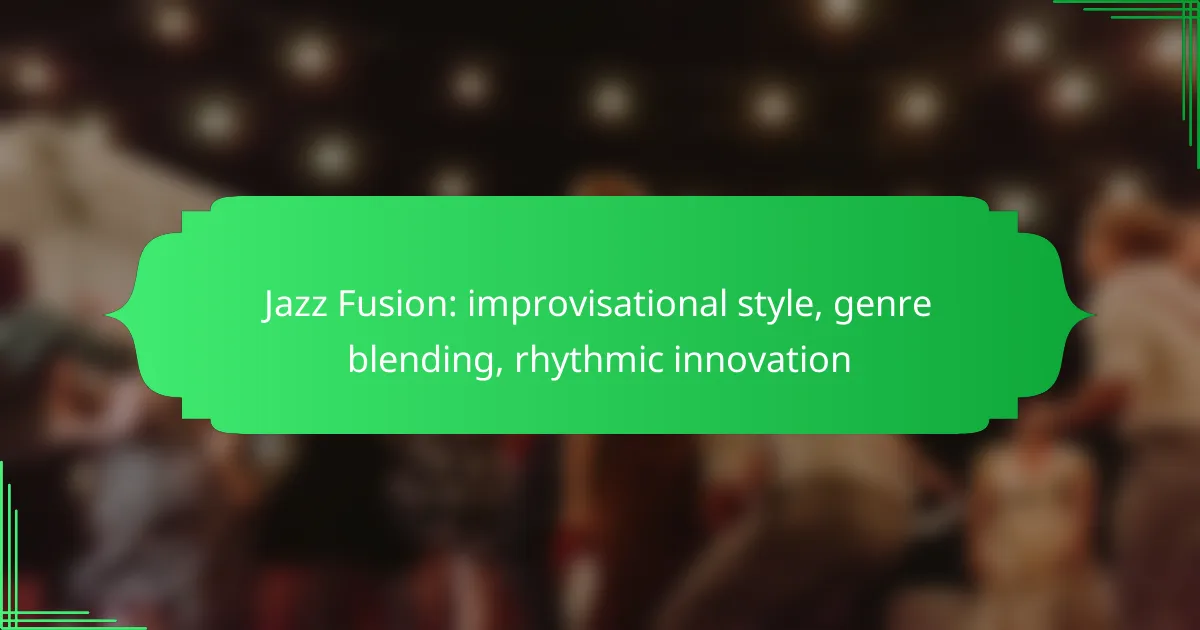Jazz Fusion is a vibrant genre that merges traditional jazz improvisation with elements from rock, funk, and R&B, resulting in a dynamic and innovative sound. This style emphasizes rhythmic experimentation and diverse instrumentation, allowing musicians to explore new musical territories. In Canada, numerous influential artists have emerged, showcasing their improvisational skills and contributing to the evolution of Jazz Fusion.

How does Jazz Fusion innovate rhythm in Canada?
Jazz Fusion in Canada innovates rhythm by blending traditional jazz elements with diverse musical influences, creating unique rhythmic patterns and structures. This genre often incorporates improvisation and experimentation, allowing musicians to explore new rhythmic territories.
Syncopation techniques
Syncopation is a key rhythmic innovation in Jazz Fusion, where emphasis is placed on off-beats or weaker beats. Canadian jazz fusion artists often use syncopated rhythms to create a sense of surprise and excitement in their music. For example, a common technique is to accentuate the second and fourth beats in a 4/4 measure, which can energize a performance.
Musicians can enhance syncopation by varying their note lengths and rests, creating a more dynamic sound. Practicing with a metronome can help develop a strong sense of timing while exploring syncopated patterns.
Polyrhythmic structures
Polyrhythmic structures involve the simultaneous use of two or more contrasting rhythms, a hallmark of Jazz Fusion. In Canada, musicians often draw from various cultural influences to create complex polyrhythms that add depth to their compositions. For instance, combining a 3/4 rhythm with a 4/4 rhythm can produce a rich tapestry of sound.
To effectively incorporate polyrhythms, musicians should start by mastering simpler rhythmic patterns before gradually layering more complex ones. Listening to recordings of polyrhythmic compositions can also provide valuable insights into their execution.
Influence of world music
The influence of world music significantly shapes the rhythmic landscape of Jazz Fusion in Canada. Artists often integrate rhythms from African, Latin, and Asian music traditions, enriching their sound and expanding their rhythmic vocabulary. For example, incorporating Afro-Cuban rhythms can introduce new syncopation and polyrhythmic elements into a jazz piece.
Musicians interested in exploring world music influences should study various cultural rhythms and consider how these can be adapted into their own compositions. Collaborating with artists from different musical backgrounds can also lead to innovative rhythmic experimentation.

What are the key characteristics of Jazz Fusion?
Jazz Fusion is characterized by its blend of jazz improvisation with elements from various genres, including rock, funk, and R&B. This style emphasizes rhythmic innovation and diverse instrumentation, creating a dynamic sound that appeals to a wide audience.
Improvisational style
The improvisational style in Jazz Fusion is a hallmark of its identity, allowing musicians to express creativity and spontaneity. Performers often engage in extended solos, showcasing their technical skills and emotional depth. This improvisation is typically built on complex chord progressions and intricate rhythms, encouraging musicians to explore new musical territories.
In practice, musicians may use modal scales or unconventional time signatures, which can lead to unique and unexpected musical moments. This freedom fosters a collaborative environment where each player contributes to the evolving sound.
Genre blending
Genre blending is central to Jazz Fusion, merging jazz with various musical styles such as rock, funk, and world music. This eclectic approach results in a rich tapestry of sounds, appealing to fans of multiple genres. For instance, the incorporation of rock’s electric guitar and funk’s rhythmic grooves creates an energetic and engaging listening experience.
Artists often draw from different influences, allowing for innovative compositions that challenge traditional genre boundaries. This blending not only broadens the audience but also encourages musicians to experiment with new techniques and ideas.
Instrumentation diversity
Instrumentation diversity is a key feature of Jazz Fusion, with ensembles often including a wide range of instruments. Traditional jazz instruments like saxophones and trumpets are frequently complemented by electric guitars, synthesizers, and percussion instruments. This variety enhances the overall sound and provides musicians with numerous avenues for expression.
In addition to standard jazz setups, many Fusion groups utilize technology, such as effects pedals and digital sampling, to create unique soundscapes. This approach allows for greater experimentation and can lead to innovative performances that captivate audiences.

Who are the prominent Jazz Fusion artists in Canada?
Canada has produced several influential Jazz Fusion artists who have significantly contributed to the genre. These musicians blend various styles, showcasing improvisational skills and rhythmic innovation that define Jazz Fusion.
Branford Marsalis
Branford Marsalis is a renowned saxophonist known for his versatility in Jazz Fusion. His work often incorporates elements of classical music and R&B, creating a unique sound that resonates with a wide audience.
He has collaborated with numerous artists and bands, pushing the boundaries of Jazz Fusion. Marsalis’s ability to improvise and adapt to different musical contexts makes him a key figure in the genre.
Pat Metheny
Pat Metheny is a celebrated guitarist and composer whose contributions to Jazz Fusion are profound. His innovative use of technology and diverse musical influences have led to groundbreaking works that redefine the genre.
With a career spanning several decades, Metheny has released numerous albums that blend jazz with rock, folk, and world music. His improvisational style and complex compositions have inspired many musicians in Canada and beyond.
Joni Mitchell
Joni Mitchell is an iconic singer-songwriter whose work often intersects with Jazz Fusion. While primarily known for her folk and rock roots, her later albums explore jazz elements, showcasing her lyrical depth and musical experimentation.
Mitchell’s collaborations with jazz musicians and her willingness to blend genres have made her a pivotal figure in the evolution of Jazz Fusion. Her ability to convey emotion through improvisation and complex harmonies continues to influence artists today.

What are the best Jazz Fusion albums to explore?
Some of the best Jazz Fusion albums to explore include groundbreaking works that blend various genres and showcase innovative improvisation. These albums are essential for understanding the evolution of jazz and its rhythmic complexities.
“Bitches Brew” by Miles Davis
“Bitches Brew,” released in 1970, is often regarded as a cornerstone of Jazz Fusion. Miles Davis combined elements of jazz, rock, and funk, creating a sound that was both experimental and accessible.
This album features a large ensemble of musicians, including notable players like Chick Corea and John McLaughlin, contributing to its rich, layered textures. The improvisational style encourages listeners to experience music as a dynamic, evolving process.
“The Inner Mounting Flame” by Mahavishnu Orchestra
Released in 1971, “The Inner Mounting Flame” showcases the virtuosic talents of guitarist John McLaughlin and his band, the Mahavishnu Orchestra. This album is characterized by its complex time signatures and rapid tempo shifts, pushing the boundaries of traditional jazz.
The fusion of Eastern musical influences with jazz and rock elements creates a unique sound. Tracks like “Meeting of the Spirits” exemplify the innovative improvisation that defines this genre, making it a must-listen for any jazz enthusiast.
“Hejira” by Joni Mitchell
“Hejira,” released in 1976, marks Joni Mitchell’s exploration into jazz-infused folk music. The album features intricate guitar work and poetic lyrics, reflecting her personal journey and experiences on the road.
Mitchell collaborates with jazz musicians like Jaco Pastorius, whose bass lines add depth and complexity to the arrangements. The seamless blending of genres in “Hejira” exemplifies how jazz fusion can transcend traditional boundaries, offering a fresh perspective on storytelling through music.

How has Jazz Fusion evolved over time?
Jazz Fusion has evolved significantly since its inception, blending elements from various genres and pushing the boundaries of traditional jazz. This genre has transformed through experimentation with improvisation, rhythm, and instrumentation, reflecting broader musical trends and cultural shifts.
Origins in the late 1960s
Jazz Fusion emerged in the late 1960s as musicians began to experiment with blending jazz improvisation with other genres, particularly rock and funk. Pioneering artists like Miles Davis and John McLaughlin were instrumental in this movement, creating a sound that combined complex jazz harmonies with the energy of rock music.
This era saw the introduction of electric instruments, which allowed for greater sonic experimentation. The use of synthesizers and electric guitars became common, enabling artists to explore new textures and soundscapes that were previously unavailable in acoustic jazz.
Influence of rock and funk
The influence of rock and funk on Jazz Fusion is profound, as these genres brought a new rhythmic complexity and energy to jazz. Bands like Weather Report and the Headhunters incorporated funk grooves and rock beats, making jazz more accessible to a wider audience.
These influences not only changed the rhythmic foundation of jazz but also expanded its audience. The incorporation of catchy melodies and danceable rhythms helped to bridge the gap between jazz and popular music, attracting fans who might not have engaged with traditional jazz.
Modern interpretations
Today, Jazz Fusion continues to evolve, with modern artists incorporating elements from hip-hop, electronic music, and world music. This genre remains dynamic, with musicians like Snarky Puppy and Kamasi Washington pushing the boundaries of what Jazz Fusion can be.
Contemporary Jazz Fusion often emphasizes collaboration and genre-blending, reflecting the diverse musical influences available in the digital age. This ongoing evolution ensures that Jazz Fusion remains relevant, appealing to both traditional jazz enthusiasts and new listeners alike.

What are the challenges faced by Jazz Fusion musicians?
Jazz Fusion musicians encounter various challenges, including the need for technical proficiency, genre blending, and maintaining rhythmic innovation. Balancing these elements while creating cohesive music can be demanding.
Technical Proficiency
Jazz Fusion requires a high level of technical skill on instruments, as musicians often navigate complex chord progressions and intricate rhythms. Players must be comfortable with improvisation, which can vary significantly from performance to performance.
To develop technical proficiency, musicians should practice regularly, focusing on scales, arpeggios, and improvisational techniques. Joining workshops or collaborating with other skilled musicians can also enhance their abilities.
Genre Blending
One of the main challenges in Jazz Fusion is effectively blending different musical genres, such as jazz, rock, funk, and world music. Musicians must understand the nuances of each genre to create a seamless fusion that resonates with audiences.
To achieve successful genre blending, musicians should study the characteristics of each style they wish to incorporate. Experimenting with different combinations during rehearsals can help identify what works best and refine their sound.
Maintaining Rhythmic Innovation
Rhythmic innovation is crucial in Jazz Fusion, as it keeps the music dynamic and engaging. Musicians often face the challenge of creating unique rhythms while ensuring they complement the overall composition.
To maintain rhythmic innovation, musicians can explore various time signatures and polyrhythms. Regularly listening to diverse music styles can inspire new rhythmic ideas and encourage creativity in their compositions.
